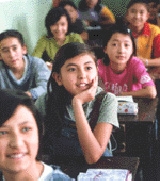 Abudo Kelim still feels a little embarrassed when talking about his first trip to Beijing.
Abudo Kelim still feels a little embarrassed when talking about his first trip to Beijing.
He came to study at the then Central Institute for Ethnic Minorities in 1964 as one of the best Uygur middle school graduates from Bachu County, in the southern part of Xinjiang Uygur Autonomous Region.
“For six months, I didn't dare to leave the campus because I didn’t know how to say ‘I am hungry’ in Chinese,” he recalled.
But the Uygur and other ethnic minority students at the Urumqi Experimental Middle School, of which 53-year-old Abudo Kelim is now the headmaster, will have none of his embarrassment when they travel across the country away from their homes in Xinjiang, thanks to the school’s extensive bilingual programs.
The experimental school, the first to offer bilingual programs to ethnic minority students in Xinjiang, has proven successful and the minority graduates have become proficient in both Uygur and Chinese languages.
Graduates of the first few classes in the bilingual program now held important positions in the regional government, Abudo Kelim said.
Under the bilingual program today, Uygur, Uzbek, Kazak and other minority teenagers in the middle school learn liberal arts subjects in Uygur and science courses in Chinese.
“This way, the minority students will not lose their ethnic cultural heritage, but they will become proficient in Chinese,” Kelim said.
Only the Han and Hui Muslim students in the school take all their classes in Chinese.
According to Abla, deputy director of the Basic Education Department of the region’s Education Commission, there was only one university and some 1,000 primary schools in Xinjiang before 1949.
Today, there are more than 10,000 primary and middle schools as well as universities in the region.
Ethnic minority students make up 64 percent of the enrolment.
The smallest ethnic minority school is a Russian primary school in Yining City, with 17 students.
The Uygurs and Kazaks not only have their own primary and middle schools but also their own colleges, where all classes, except Chinese language program, are offered in Uygur or Kazak languages.
The Xibes and Kirgizes teach both their own languages and Chinese.
Meanwhile, according to Upur Asim, deputy director of the region’s Education Commission, bilingual experimental programs, teaching both Chinese and Uygur, Kazak or Mongolian languages, were introduced in 27 middle schools in the region by June last year, involving 2,629 students.
Today, more than 3,500 students attended the bilingual experimental classes, Abla said.
The bilingual programs have proven popular and ethnic minority students from the experimental classes have successfully moved on to leading colleges and universities, not only in the region but also across the country.
All of the 107 graduates under the bilingual teaching program at the Urumqi Experimental School this year have entered universities this month. Abdukelim Abla took first place amongst all the ethnic minority college applicants in the region during the national college entrance examinations in July.
According to Wu Jiansheng, another leading administrator at the Urumqi Experimental School, the bilingual programs, which were tried in the 1960s but stopped later and reintroduced only six years ago, didn’t go to plan at first.
The Han teachers, who were used to more docile Han students, took time to adjust to the Uygur and other ethnic minority students “who are more lively and active than the Hans,” Wu said.
The teachers discovered that the Uygur and other ethnic minority children were as responsive, quick-minded and cooperative as the Han students, Wu said.
Many younger ethnic minority children in cities in Xinjiang now learn both their mother tongue and Chinese from a very young age.
The Urumqi No 5 Primary School, one of the best in the region’s capital for Uygurs and other minority children, now offers Chinese language classes to many first-year students.
“I can read many fairy tales in the Uygur language but I watch Chinese language programs such as `Conan’ (a Japanese children’s detective cartoon series) on CCTV,” said Zubkar, 11, a fifth grader in the school. The other much-loved cartoon series, which has been translated into Uygur, is Warner Brother's “Tom & Jerry.”
Students start computer classes in their third year at primary school. Uygur language software is installed to teach the students how to type in Uygur.
The students in the school also run their own television station. Amina, a sixth grader, is one of the best student anchors. “My idol is Myila, an anchor woman with the Xinjiang Television station,” she said.
Salaydin, also a sixth grader, however, said he wanted to get a Ph.D when he grew up.
Going to the best universities in the country is what Salaydin and other teenage ethnic minority children aspire to.
When asked where they would go for college, the students from two classes in the Urumqi Experimental Middle School’s junior section replied with confidence that they would go to Beijing and Shanghai for the best university education in the country.
(China Daily 09/28/2000)
